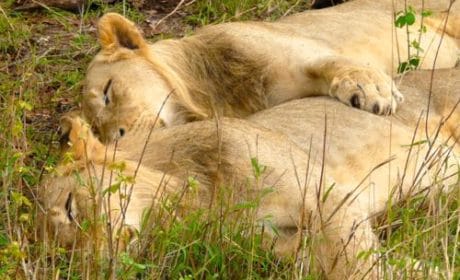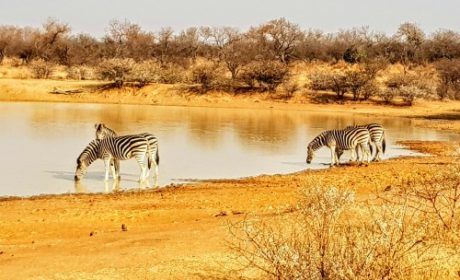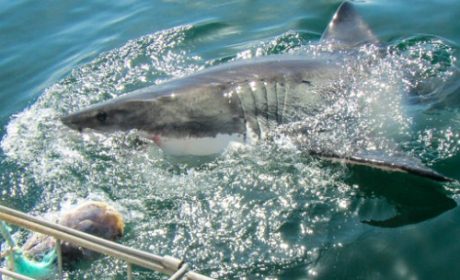When most people think of safari, they almost immediately think of Kenya. However, there are some various places in Africa where animal watching in their natural habitat is just as amazing.
A safari through Uganda may not be the first option that comes to mind, but, from the looks of it, it should be. Let our guest contributor, Whitney Rider, take you on an amazing wildlife photo tour of just what this beautiful country has to offer.
When most travelers get a hankering to go safari, they generally default to Kenya and Tanzania, or perhaps the well-traveled park circuit in South Africa. A recent tour through Central Uganda proved it a more than worthy addition to the list. Though Uganda cannot match the Serengeti for herd size, what it lacks in sheer numbers it makes up for in a more intimate experience. In a country slightly smaller than Oregon you can find savannah, bushland, wetlands, lush forest, and even semi-desert. You can (photo) hunt the Big 5 (lion, elephant, buffalo, leopard, and rhino), fish for a Nile Perch, or spend a day tracking Mountain Gorillas. You can relax in canvas tents or a five star safari lodge or test your mettle in Jinja, Africa’s ‘adrenalin capital.’ My husband and I quickly wished we had had more than a single whirlwind week to explore.
A word of advice to start – hire the professional driver. Being seasoned road-trippers, we originally planned to drive ourselves. Uganda’s tourist industry politely discourages this by making it nearly impossible to rent a four-wheel drive vehicle without a driver. As it turns out, while only the vehicle is necessary for navigating Uganda’s rural roads and park tracks, the driver is necessary for navigating the almost entirely unmarked roadways. In addition to eliminating the stress of getting where we wanted to go, when we wanted to get there, our driver, Francis, knew all the important unmarked spots – like the best place to find great food (e.g. who makes the best chapati), the closest ATM, the highest quality souvenirs, and less-frequented photo opps.
Hitting the Road
Many of Uganda’s tourists come specifically for the spectacular Gorilla watching in Uganda’s far southwest corner. If you get this opportunity, you should surely do it, but be sure to plan ahead – permits for gorilla hikes are often reserved far in advance. Our trip was a spur-of-the-moment opportunity spontaneously tacked on to a work trip in the region, so we maximized our time by touring Uganda’s central wildlife parks. Due to a travel snafu with Kenyan Air, arrival in Entebbe occurred late in the afternoon rather than early morning, making us even more grateful for Francis who met us at the arrivals gate and had us on the red clay roads pointed towards Lake Mburo in about five New York minutes.
A late start ensured an arrival at Lake Mburo National Park in darkness, which, if you haven’t been to rural Africa, means reach-out-and-touch-it DARK. Albeit with incredible stars. Left to our own devices we probably would have slept in the car, not trusting ourselves to find the right one lane track to our lodge. Fortunately, we had Francis, ensuring that not only was dinner awaiting our late arrival at Mburo Safari Lodge, but that we woke up the next morning to a personal walking safari with a very amiable and knowledgeable park ranger rather than stiff necks and slept-in clothes.
Experiencing the park on foot is a less common experience and much more enveloping. Not only is it quieter, you can smell the earth and inspect the plant life and literally track the footsteps of the animals. As darkness gave way to morning light zebra and impala emerged from the mist (Mburo is the only place to see these two animals in Uganda), and topi, and bushbucks came foraging their own breakfasts. Everywhere there were warthogs. Proud, amusing, entrancing warthogs. After a few hours of stalking the local fauna, we returned to the lodge and had the entire breakfast patio and vista to ourselves for breakfast. Not a bad view…

A longer stay to track down the lion pride newly returned to the park would have been incredible, but a tight schedule dictated departure for Queen Elizabeth National Park, a 1,978 square mile reserve with one of the highest biodiversity ratings in the world. As any savvy realtor knows, it’s all about location, location, location, and Kyambura Game Lodge clearly got the message. Perched atop a dramatic overlook of Kyambura Gorge, a stay is worth it for the views alone. Lunch at the poolside restaurant will lure you with prospects of pampering, but don’t linger overly – you will want to leave time to descend the gorge and grab spots on one of the afternoon boat trips through Kazinga Channel. Cruising along at a photo-friendly pace, you can get up close and personal with all sorts of local characters, like this poster-ready hippo who was keeping an eye on us.

Other sightings included striding elephants, an elegant and fierce bird of prey dining in a tree a few branches away from a lone colobus monkey, and herds of the heavy horned water buffalo, not to be confused with the more wary, stately horned waterbuck. There was also an intimidatingly large Nile monitor lizard best appreciated from on board the boat. Animals aside, the scenery itself is arresting.

Kyambura’s al fresco dining is quite lovely despite the occasional mosquito (wear long sleeves and pants) and the bar is a character unto itself, resembling the canoes sighted earlier on the water, though split in half and hewn into a stone bed. Again, a longer stay would have scratched the itch to track down Uganda’s only tree-climbing lions (they lounge exclusively in the far southern quarter of the park), but scheduling and routing took us north. We contented ourselves with a morning drive through the park’s well-populated northeastern sector.
The afternoon drive included a scenic pass through several of Uganda’s commercial tea farming districts. East Africa’s coffee beans are rightfully adored by many coffee fanatics, but Uganda also maintains a thriving tea industry and the tea habits to go with it. Not having considered the agricultural requirements of this particular product, the rolling green tea fields were a pleasant surprise. The approach to Kibale Forest National Park is signaled by the transition from tea fields to overhanging tropical forest and the sudden appearance of many baboon families along the increasingly forested roadway.

Though small as parks go, Kibale is one of the most densely populated primate zones in Uganda, and arguably in Africa. If you are lucky, you may not even have to track the chimps, being well positioned to catch a glimpse of them from the porch of a solar-powered bungalow at Chimp’s Nest lodge. In addition to a daytime chimp track, you can also participate in night hikes through Kibale forest. While an nice change from tracking animals by car, the night hikes are often more of an exercise in hearing, not seeing, the wildlife.
Maintaining breakneck pace, we charged off the next morning bound for Murchison Falls National Park. Uganda’s largest park is visited as much for its waterfall as its animals and, as befits its legacy as one of Africa’s most famous parks, its luxury lodges (Paraa and Chobe at opposite ends of the park being the two most highly sought). A road closure on the one of the common thoroughfares necessitated a re-routing (another reason to be thankful Francis was in charge) but we made it to the park in time for a late afternoon drive, glimpsing even in this shortened window a panoply of animals including the heretofore unseen Jackson’s hartebeest – an unusual, flat-faced antelope specific to Uganda, and a pair of snacking giraffe’s which we stopped to watch for at least 40 minutes (a benefit of the non-group tour!)

The re-route prevented us from getting all the way to Chobe that night. Such hiccups, while not common, are not uncommon in cross-country travel in places where road networks are not what they could be. Pack your flexibility next to your guidebook and all will be well. We spent that night outside the park at the spare but aging-gracefully Masindi Hotel, where we lounged at the Hemingway Bar with a cocktail in honor of author, who reportedly recuperated there (in Room #6) after a local plane crash. The next morning we re-entered the park and caught the boat launch on the Victoria Nile, resuming our planned itinerary. We churned upriver for about 90 minutes, with cameras in action nearly the entire time including this magnificent lone elephant.

The launch is an out-and-back, turning around at the base of Murchison Falls, for which the park is named. But those who are interested can disembark at a modest dock (i.e. rock outcropping) and continue on foot along the Top of the Falls walk. A small number of us jumped at the opportunity (literally) and for this moderate exertion of effort were rewarded with much grander perspectives on the Falls and the cooling mist of spray on our faces. You can descend again to catch a ride back on the next launch, but we opted to have Francis meet us at the top of the falls where we explored the park between the Top of the Falls and Chobe Lodge, where even a Standard Tent is a luxury.

The next day we began reluctantly making our way back towards Kampala. En route, we stopped at the Ziwa Rhino sanctuary, a private reserve opened in 2005 to help restore Uganda’s southern white rhino population. Uganda’s wild rhino population was decimated by poachers decades ago, and the Ziwa project, jointly sponsored by the Rhino Fund Uganda and the Uganda Wildlife Authority, aims to rebuild a sustainable rhino population in order to reintroduce them to the wild. Each rhino or rhino family (in the case of females with children) at the sanctuary has its own bodyguard – an anti-poaching ranger who shadows the animal(s) 24 hours a day. Because the rhinos’ whereabouts are tracked continuously, you are guaranteed a sighting, and in the watchful company of one ranger/guide and one ranger/bodyguard, your on-foot visit can be a fairly close and personal one. The rhinos’ current familiarity with humans, may pose an interesting challenge to their ultimate reintroduction to the wild, but for now, it allows for a uniquely intimate viewing experience.

Return to the capital allows for some of the requisite market shopping and Kampala is one of Africa’s more pleasant capital cities to explore. A dip in the plunge pool at Le Bougainviller Hotel is also appreciated after a day in a van. This modern and well-appointed spot is a little oasis tucked away in the busy city. The in-house French restaurant was a perfect “last meal” before our final adventure – rafting the Nile.
Rousing ourselves in the near dark of our last full day in Uganda, we hit the road for the two hour-ish drive to Jinja. On arrival at Nile River Explorers we met our guides and fellow rafters for our five-hour run down Uganda’s whitewater. The rafting covers a 25 kilometer course and includes a series of rapids ranging from grade 3 to 5. Although ‘grade 5 rapids’ might sound intimidating to the uninitiated, everyone in our group, from first-time novice to experienced rafters, loved the trip – rapids, cheese-snax, and end-of-day BBQ included.
As Francis escorted us back to Entebbe that evening, we were already making a list of the things we hadn’t had time to do – horseback safaris, the Rwenzori mountains, the gorillas! Although road conditions occasionally make travel time between destinations longer than it appears on your map, we found this inconvenience easily outweighed by the lesser crowds, more personalized viewing experiences, and frequent one-on-one or very small group engagement with rangers and guides. Longer stays at the larger parks are definitely recommended to take advantage of their sometimes far-flung attractions, but even our rapid fire pace allowed for premium experiences. Having tested these waters, we’re eager to return.
Have you ever been on a safari through Uganda? Come join the conversation at the My Itchy Travel Feet page on Facebook. Or send us an email with your thoughts.



